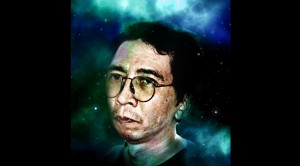
Building that universe began very early for the 46-year-old David Peter Jose Jalandoni Hontiveros, the youngest child of Benjamin, who worked for San Miguel Corporation, and homemaker Flory. In grade school at La Salle Greenhills, the younger Hontiveros discovered he had a taste for words.
“We had really good English teachers,” he recalls. “We had these writing exercises when you could just write whatever you wanted in journals. So I would have these little vignettes where I would copy the style of an author I liked and see if I could do it. I kept on doing that. At a certain point, the teachers realized I was interested in the language, so they would give me exercises that the other guys wouldn’t have to take home. It all built up, over time.”
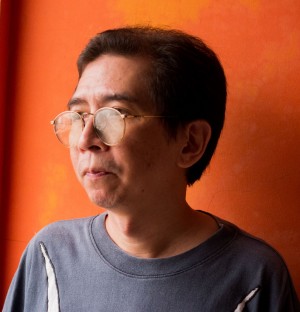
When his family went through financial problems, Hontiveros realized he would not be able to go to the States after all. “I was just wasting my dad’s money with the tuition and I wasn’t learning anything. The math and computer subjects were killing me. I just kind of stopped.”
It certainly helped that he had found how he truly enjoyed writing. After joining a Halloween horror writing contest, Hontiveros delighted in winning both the 2nd and 3rd prizes. In 1993, he began collaborating on a comic book called “Flashpoint” with a fellow LaSallian who would become a frequent collaborator and a comic book genius in his own right: Carlos Vergara, better known as the creator of the gender-swapping superheroine Zsazsa Zaturnnah. Hontiveros was one of the first members of the seminal Filipino comic book creators’ group, Alamat Comics.
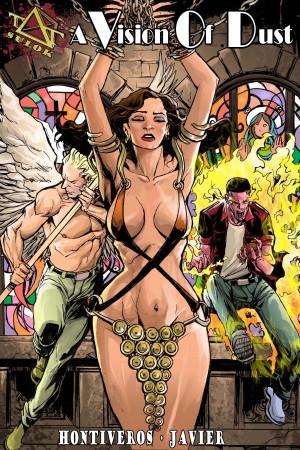
Away from comic books, Hontiveros dove deep into a relatively unusual area of writing: horror. He had been indoctrinated early as he recalls his mother being an avid reader of horror stories. He remembers his parents bringing him to watch “The Omen.” The movie was rated R in 1976; Hontiveros was just 8 years old then. He became a huge fan of stop-motion pioneer Ray Harryhausen, who had animated the creatures in films like 1958’s “The 7th Voyage of Sinbad,” 1963’s “Jason and the Argonauts” and 1981’s original “Clash of the Titans.”
It was then that Hontiveros came to a realization about the nature of his writing: “It was all of this fantastic stuff early on. At a certain point, I realized you could use it as a platform to talk about serious real-life stuff, which was something that (founding editor) Karen Berger of (DC Comics’ imprint) Vertigo did, where you could use the genre to tackle issues. I could talk about child abuse or racism or war or hunger but it’s not as uncomfortable. With social realism, people get uncomfortable and turned off. But if you couch it beneath horror or science fiction or fantasy, they accept it more readily. And then in my head it’s like stealth, you present them on the surface beneath that; they’re getting it through osmosis and hopefully it registers.”
These were certainly big ideas, but back then, Hontiveros was one of the imaginative voices in the publishing wilderness. “I would rather be known as a good writer who happens to writer horror, science fiction or comics rather than, ‘oh, he’s the horror writer or he’s the comic book writer,’” he says. When he started out over a decade ago, the market for genre writing simply wasn’t there. You put out your own comic books, had exhibits in Robinsons Galleria or Club Dredd and kept plugging at it.
To survive, Hontiveros took the freelance writing gigs offered by writer friends like Karen Kunawicz and “Trese” braintrust Budjette Tan. “It was nice because you were kind of writing regularly, honing your skill,” he says. He wrote a lot: film reviews, film scripts, not your usual feature articles. “Again, it’s because I know I am good at this, at what I do. And I know that the stuff I write is my voice—there isn’t anyone else around who writes like that. I’ve been asked if I can write ‘normal’ stuff and I’ve done that. You kind of have to find what you’re good at and you find that nobody else is doing it,” he says with emphasis.
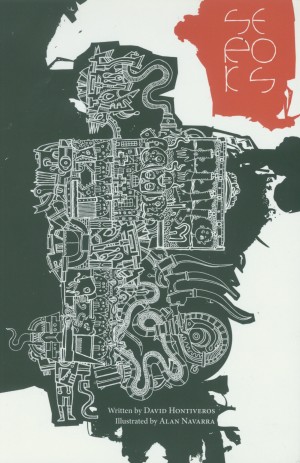
That audience came suddenly in the 2000s. Genre writing and geekdom was suddenly popular. The comic conventions blew up. Comic book and genre creators became rock stars.
Amid all that, Hontiveros became kind of overlooked, the perfect man at an imperfect time. “You can’t help but hear that gremlin voice in the back of your head, even with comics, and I kind of stepped away from it,” he recalls. “The thing with comics is that you’re always collaborating with an artist. A lot of the time, because we’re not being paid, the artist has to squeeze it in. That’s why Alamat had a lot of first issues, but it was harder to find second issues. So that kind of accumulated. That was why, when I decided to come back to comics, I decided to do it big time. I’m doing a lot of stuff. Because I had felt that comics had kind of left me behind. You need to take that little negative voice and turn it into this positive drive to do stuff.”
But he had never stopped working at it and he soon gained recognition. In 1997, his comic book “Dhampyr,” illustrated by artist Oliver Pulumbarit, became the first comic book to be a finalist for a National Book Award. In 2002, Hontiveros won a Carlos Palanca Memorial Award for Literature for his short story, “Kaming Mga Seroks.”
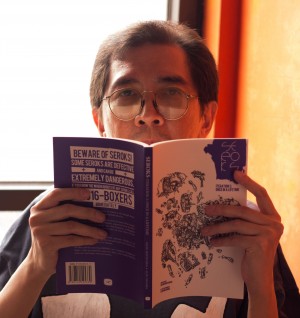
In 2005, Visprint published his trilogy of horror novellas under the Penumbra umbrella, “Parman,” “Takod” and “Craving.” Hontiveros had shown the first four chapters of “Takod” to Visprint’s Nida Ramirez, who asked if he could do more of it so they could put out three books. “The first time Visprint published David’s stories, we weren’t that much aware of the horror market in the country,” Ramirez recounts. “It was still ‘True Horror/Ghost Stories’ that was quite popular in the market. I cannot say what makes him unique but I can say that I enjoy reading his stories because of how David creates ‘new worlds’ for them.”
In 2009, two of Hontiveros’ stories appeared in the Summit Media horror anthology “Underpass,” one with art by Pulumbarit and the other by “Skyworld” creator Ian Sta. Maria.
Hontiveros took a big step back into the spotlight with the 2012 novel “Seroks Iteration 1: Mirror Man,” published by Visprint with illustrations by Alan Navarra. He had reworked “Kaming Mga Seroks” into the first chapter of the book. It’s a third-world clone drama, kind of a Filipino setting for something like the 1982 film “Blade Runner,” with the pirated seroks clones instead of the rogue Replicants. (Please see sidebar for an excerpt) Hontiveros used the story as the springboard for more stories, and the first book was followed in 2014 by “Seroks Iteration 2: Once in a Lifetime.” Hontiveros and Navarra are working on the planned final book in what is now a trilogy, with publication planned for late 2015.
Hontiveros has become even more productive with comic books, in particular, writing a line with characters that exist in the same universe as his first book, 2005’s “Parman.” He calls this imprint The ‘Verse, and is currently pitching a collected edition of one of those series, “Tatsulok: A Vision of Dust,” to publishers. The ‘Verse is a Filipino superhero saga with elements of both lower and higher mythology.
“What I noticed is that a lot of people go for the lower mythology—the tikbalang, manananggal, that stuff—not everyone goes for the higher mythology. The ones who did are ‘Skyworld’ and ‘The Mythology Class.’ That’s what I do and I also inject and take the Joseph Campbell mythology approach, that it’s all the same myths but different cultures. That’s what I try to do, take our local high mythology and try and show where it merges with world mythology.”
Of Hontiveros’ writing prowess, Tan says: “Dave said that one of the ways he learned how to write was when he’d play the role of Dungeon Master/game master whenever he and his friends played RPG (role playing games). He made it a point to create an immersive world for his players and I think he does the same thing for his readers. He’s a world-builder and he makes sure he knows every corner of his character’s universe before he lets his readers enter it.”
For his comic book work, Hontiveros has been all the right things. He’s been attending the Komikons, and he’d like The ‘Verse to hit bookshelves. “That was always the plan,” he says, noting that creators like Vergara and Gerry Alanguilan had led the way in that.
What is the long-term goal? “I want to reach a point where the Philippnes becomes a country where you can earn a living as a writer without needing to do 9-to-5, without needing to do freelance stuff. That’s a big thing. Somewhere the line I would like, and I know I’m not the only writer like this, for all of us as a collective to get there. Once in a while, you get the feeling there is a mass audience, but the idea is to keep it at a constant level where everybody can have that mass audience.”
Now the big challenge is finding enough of an audience. “After a while, you know there’s a certain ceiling with the conventions and the comic book stores. The idea is to get into the big bookstores like National Book Store,” Hontiveros explains. “So when the time comes that everyone gets on the shelf, it’s not just ‘Trese’ or ‘Skyworld.’ I look forward to the day when anyone who comes out with a really good comic book can eventually get to those book stores.”
It’s become the quest for the barcode—or the ISBN. Visprint has been doing that for many of the independent comic book artists. It’s about being “scannable” by the bookstores’ point-of-sales terminals. “You want to be scannable, but you want to have your own voice,” Hontiveros counsels.
It’s also all about the collected editions now, instead of the separate issues, dubbed “singles.” Hontiveros says. “The singles are just to have a presence at the conventions because you also have your core fanbase who really follow you whatever you do. People come up to the convention tables and ask if you’ll compile (your stories). Of course, yes, I will eventually. You just need the artist to finish and a publisher who’ll want to publish you.” Additionally, the royalties from the collected editions makes it important to have as much product out there as possible.
Success may now become a matter of timing. Things seem to have been set up for Hontiveros’ work to be rediscovered. There’s an audience out there now. The prospects are better and he actually helped set up these prospects—he just didn’t know it at the time. So it’s kind of like Hontiveros traveled through time to help his future self.
“Dave is the classic example of what happens when you just write the story and you don’t hustle enough to pitch it,” Tan says. “Dave is probably the most prolific author I know with the most number of unpublished stories. So, I’m glad that he’s finally getting more stories published and getting more people to read them.”
It helps that genre writing has become acceptable. “Filipinos are quite fond of horror, fantasy and myths. We can mostly see this from television shows and movies produced in our country,” Ramirez says. “Almost all of the Visprint horror books have been well-received by the market.” Master writers like Gregorio Brillantes worked in science fiction with stories like “The Distance to Andromeda.” The genre has become mainstream now.
Hollywood helps, Hontiveros says, with the movies adapting comic book materials. The pop culture market has also changed. “It became, much as I hate the word, “cool” to do that, to kind of like that. People like me were into that in the ’70s. Back then, you were a geek because it was something you didn’t choose.”
He notes that the widespread acceptance of geekdom is immensely important, but it also somewhat dilutes the fandom, creating what he calls “McGeeks,” people who deal with geek causes because it makes them popular. “I fly my geek flag high,” he says proudly. Thus, in many ways, Hontiveros will never be mainstream in the strict sense of the world, even if his work finds mainstream acceptance.
“The whole ‘stealth’ thing makes me different,” he says. “When I look around, I see there are good writers but sometimes it’s good writing but I can’t find anything beneath it. That’s not bad, it’s just different. For me, I appreciate the stuff that’s below that you sometimes have to dig for. It’s a double-edged sword because sometimes, people don’t see it. I know I’m saying stuff aside from just the story.”
Asking him what he does in his spare time is kind of goofy, considering that, in Hontiveros’ case, all of his time is spare time. He enjoys television (his favorites include the British sc-fi series “Black Mirror”) and reading comic books (favorite authors include Neil Gaiman, Alan Moore and Grant Morrison, among many others).
But what he seeks is to write even more than he is already doing, that includes all the possible universes, the scary, the futuristic, the visual and the fantastic. “When I start to write something, this fire gets lit under my ass and I just keep writing, so you wait for that,” says David Hontiveros, eyes bright behind his glasses, his pupils multiplying in the light, like worlds being born. •














































